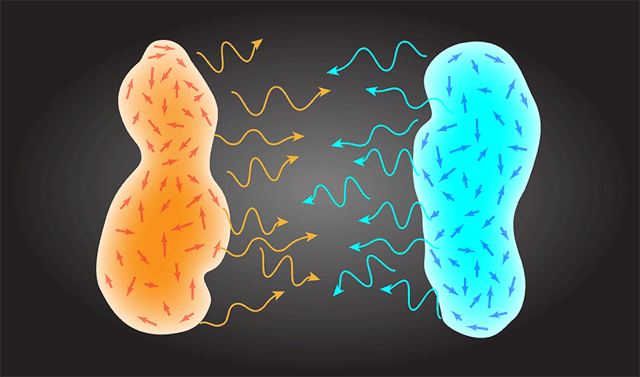At astronomical distances, heat is transferred between a warm body, such as the sun, to a cooler body, such as Earth, by light. At ambient conditions here on Earth, when you try to cook a meal on the stove heat is also transferred by electromagnetic radiation, but mainly using an infrared wavelength of about eight microns which is invisible. When two bodies are really, really close to each other but not exactly in contact, such in the case of sensitive electronic components found in processors, the equations physicists have used to describe heat transfer between two bodies crumble.

Two bodies at different temperatures in vacuum constantly exchange heat. This energy flux is mediated by photons (shown here as wavy lines), which are generated by thermally fluctuating electrical currents (arrows) inside each body. Credit: APS/Alan Stonebraker
Finally, a team of researchers have bridged the gap and found an accurate mathematical equation that can determine the “spectral radiative heat transfer rate between two closely spaced bodies, generalizing the concept of a blackbody to the case of near-field energy transfer.” This analysis suggests that the heat transfer between two close bodies can be millions of times higher than previously thought.
Of course, through trial and error, the industry has learned that any attempts to use Stefan-Boltzmann law’s to determine heat transfer between close bodies is fruitless. Instead, engineers have empirically learned which materials are better and even devised loose approximations to calculate which components heat less or more when in close contact. The new formula devised by researchers at Princeton and MIT is far more accurate and helpful.
According to the Stefan-Boltzmann law, the upper limit on this overall heat exchange simply hinges on any two bodies’ temperatures. The benchmark for comparison is a theoretical “blackbody,” which perfectly absorbs all radiation that alights upon it. This is true for the far-field heat radiation, but for the near-field the heat transfer can vastly exceed the blackbody maximum.
What happens is that when objects are really close — when the distance is less than the primary wavelength of heat — a different electromagnetic wave called evanescent waves dominate. These dissipate rapidly with distance which is why they’re not important in everyday heat transfer. At the nanoscale, these rule.
These waves can been seen as light that’s trapped in a body always reflecting, but never breaking free like typical radiation. These can tunnel the object if another object with its own evanescent waves is placed very close.
The authors tackled this fundamental problem using a model that describes radiative heat transfer as originating from fluctuating electrical currents within the two bodies. Such currents result from electrical dipoles whose values vary because of both thermal and quantum fluctuations. Alejandro Rodriguez, an assistant professor of electrical engineering at Princeton and colleagues incorporated key new features that don’t show in Stefan-Boltzmann’s law to account for near-field radiation transfer like: the flow of electrical current within objects, the conservation of energy, and “reciprocity,” the ability of either object to act as a heat receiver or absorber.
The resulting formula can determine heat rate transfer conveniently only function of the two materials’ properties and the distance of separation.
“What we’ve done is found a generalization of the Stefan-Boltzmann law to situations where objects are right on top of each other,” said Rodriguez. “Now we want to figure out what structures and materials can approach the limits described by our new equation.”
“We now have a ceiling for how much heat transfer we can expect,” he added. “The fact that this ceiling is several orders of magnitude higher than has been previously demonstrated in existing material structures is extremely promising and will motivate further studies of this phenomenon and its many applications.”
The findings appeared in the journal Physical Review Letters.









